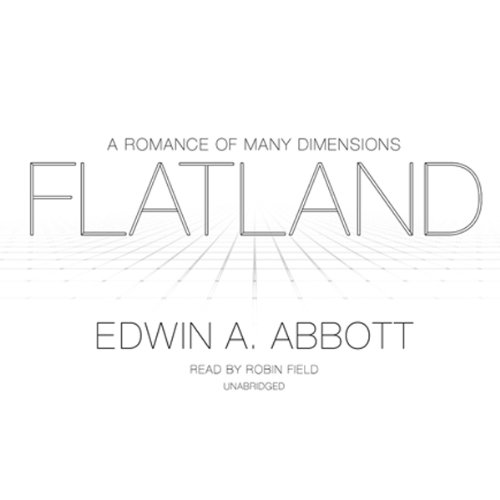![]() Flatland: A Romance of Many Dimensions by Edwin A. Abbott
Flatland: A Romance of Many Dimensions by Edwin A. Abbott
 Flatland: A Romance of Many Dimensions, published in 1884, is Edwin A. Abbott’s social satire and Christian apologetic. As a Cambridge mathematician, theologian, and schoolmaster, Abbott had a lot to say about his Victorian society and about being open-minded to the supernatural. He does this from the point of view of a humble square that lives in Flatland, a world of only two dimensions.
Flatland: A Romance of Many Dimensions, published in 1884, is Edwin A. Abbott’s social satire and Christian apologetic. As a Cambridge mathematician, theologian, and schoolmaster, Abbott had a lot to say about his Victorian society and about being open-minded to the supernatural. He does this from the point of view of a humble square that lives in Flatland, a world of only two dimensions.
For the first half of the book (“This World”), the square explains the demography of Flatland, all the while offering hilarious social satire. He begins at the lowest social stratum (women, who are straight lines) and ends with the king, who has so many sides that he’s indistinguishable from a circle. Low-class men, such as soldiers, are isosceles triangles with sharp acute angles. Since the brain is the size of the smallest angle, these men are stupid, but their sharp angles provide offensive weapons. Anyone who has an angle under 60° is a serf. Women, of course, have no angles, which means they are brainless and irrational (and Abbot provides plenty of tongue-in-cheek evidence for this fact). But women have a mouth on one end, and it can effectively be used as a dagger. When viewed from the back, a woman is hard to notice since she is seen only as a point, thus she must sway her bottom back and forth to alert others of her dangerous presence.
Pretending that he’s merely explaining Flatland society to his readers in “Spaceland,” Abbot mercilessly mocks his era’s class structure, fashion, aristocratic marriage and parenting practices, the education system and school board politics, and government. All of this is done in a reasonable-sounding lecturing tone:
Obviously then a Woman is not to be irritated as long as she is in a position where she can turn round. When you have them in their apartments — which are constructed with a view to denying them that power — you can say and do what you like; for they are then wholly impotent for mischief, and will not remember a few minutes hence the incident for which they may be at this moment threatening you with death, nor the promises which you may have found it necessary to make in order to pacify their fury.
In the second half of the book (“Other Worlds”) the square explains his vision of a one-dimensional realm called “Lineland” where he meets the king of Lineland who can’t imagine Flatland, a world of two dimensions. The square thinks this is amusing, so he torments the belligerent king by using the second dimension to speak to the king from above, to magically pop in and out of the King’s view, and to offer predictions about who is approaching the king from afar (see the image below, which comes from the book). With his omniscience and omnipresence, the square bewilders the king of Lineland.
Upon his return to Flatland, the square is confronted by a sphere from our Spaceland of three dimensions who, poised in the third dimension, can view all of Flatland. To the Flatlanders the sphere looks like a circle of changing diameter, and to Linelanders he seems to be only two lines (see the image below). The sphere can pop in and out of Flatland and Lineland as he wills, can see inside (and even manipulate) houses and bodies, and can make predictions about the future based on what he sees from his viewpoint. Our square, who harassed the king of Lineland for his inability to imagine Flatland, is now flummoxed at the thought of a dimension he can’t perceive, but he believes it because he has witnessed the sphere’s power and he remembers his analogous encounter in one-dimensional Lineland. When the square tries to preach this new teaching, though, he meets resistance from unbelievers.
The metaphor, of course, is that we in Spaceland, being confined to only the dimensions we are able to perceive, can’t imagine more dimensions in which other beings exist and may be able to visit, view, or manipulate us. This idea isn’t at all new to me, but I found Abbott’s explanation to be a very convincing line of reasoning and, perhaps, a way to imagine what it must be like to be God. Flatland is best known, by the way, as a treatise on dimensionality and is considered by scientists to be prophetic in its use of unseen dimensions to explain physical phenomena.
Flatland is available in the public domain, but I chose to listen to Blackstone Audio’s recent version which is four hours long and read by Robin Field. The audiobook does not come with Edwin Abbott’s drawings, but I had no trouble imagining them because they’re thoroughly described by Abbott in the text. However, it’s easy to refer to them in public domain sources if you wish. I loved Robin Field’s narration and, even though the material seems heavy, I didn’t have any problem following along. I did, however, have to maintain constant focus just to translate all of the geometric metaphors into social analogies during the first section of the book. For that reason, Flatland is hard work, but immensely rewarding. I thought it was brilliant.





It sounds difficult and wonderful. I like that you get some geometry along with the whimsy and social commentary!